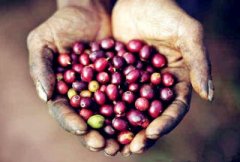What's the difference between Panamanian Rosa coffee beans and Guatemalan Rosa coffee beans? Panamanian coffee
In the early years, most of the recognition of top coffee followed Japan, one king of coffee followed Jamaica Blue Mountain and Hawaii Kona, but with the continuous improvement of coffee producing countries and information sharing, we were exposed to more fine coffee, and this coffee bean Panama rose summer became the new king of coffee in recent years.

The seeds of Geisha were discovered in 1931 in Ethiopia's rosewood forests and sent to coffee research institutes in Kenya; introduced to Uganda and Tanzania in 1936, Costa Rica in 1953, Panama in the 1970s by Francesco Serrazin of Domba Seven Farm, who distributed seeds from CATIE in Costa Rica and began growing rosewood coffee.
Geisha, carrying the power of a hurricane to sweep the coffee world, this coffee revolution is fierce, so that the coffee kingdom has long occupied the throne of one king and one queen--Jamaica Blue Mountain, Hawaii Kona also have to retreat, this wild variety originally from Ethiopia, after experiencing countless battles, is now valued in all major coffee producing areas, and its best spokesman is from Panama "La Esmeralda" estate.
History of Esmeralda Farm: In 1924, Swedish Hans Elliot founded Esmeralda Farm, which was not a coffee plantation but a pasture. Forty years later, in 1964, Ludwig Peterson's grandfather Ludwig. Mr. Bidsson bought Esmeralda Farm in order to have a place to live in retirement. His grandfather, Mr. Ludlow Bidsson, was born in Sweden and served as President of the Bank of America and Director of the United Nations Development Agency. His son, Mr. Braith Bideson, moved from California to Panama in 1973 to inherit his father's farm. In 1987, most of the farm was converted to coffee cultivation. In 1994, he invested in the purchase of refined coffee machinery in order to establish a brand. Mr. Braith Bideson and his wife Susan raised three children, Eligu, while the coffee farm was officially operated.(born in Philadelphia, 1966), Richelieu (born in Sweden, 1967), Daniele (born in Panama, 1974).
In 1996 Braith and Rachel visited a farm for sale in the Haramijon area of the Boketty Valley and were attracted by the beauty of the farm and immediately bought it. This is Esmeralda. Harami Jonon Farm, third son Danielle. Mr. Bideson planted the coffee world's attention on this farm-Geisha coffee!
Geisha, pronounced geisha in Japanese, is also known as geisha coffee; because the tree is taller than ordinary coffee trees, it was originally planted in a small area of the estate and used as a windbreak. The son of the owner of the estate, in order to participate in the annual Panama Best Coffee Competition, searched all the coffee trees in the estate to do the test, so that Geisha had the opportunity to appear; after that, he also participated in various international coffee competitions and won a total of eleven championships.
Important Notice :
前街咖啡 FrontStreet Coffee has moved to new addredd:
FrontStreet Coffee Address: 315,Donghua East Road,GuangZhou
Tel:020 38364473
- Prev

How do Yega Chefe Coffee beans and Brazilian beans tell the difference between Yega Chefe Coffee and Brazilian Coffee
It is difficult to tell from the appearance, but it is easy to tell from the smell. The taste of the two kinds of coffee is completely different. Brazil smells only one smell of coffee and no other special flavor. Yega snow coffee will smell sour and floral. If you drink, it is more obvious, the simplest, the same way, which is sour and which is Yejasuffe.
- Next

What is fine coffee? Features of Boutique Coffee Unique Flavors of Boutique Coffee Boutique Coffee
Specialty coffee is also known as specialty coffee. It refers to coffee made from green beans with excellent taste characteristics grown in a few extremely ideal geographical environments. Depending on the particular soil and climatic conditions in which they are grown, they have outstanding flavors. This coffee is then carefully selected and graded for its hard texture
Related
- Guji coffee producing area of Guji, Ethiopia: Humbela, Shakiso, Wulaga
- What is the most expensive variety of Qiloso in BOP multi-variety group?
- How to store the coffee beans bought home?
- Why are Yemeni coffee beans so rare now?
- Ethiopian Sidamo all Red Fruit Sun Sun Santa Vini Coffee beans
- SOE is mostly sour? What does it mean? Is it a single bean? what's the difference between it and Italian blending?
- Is Italian coffee beans suitable for making hand-brewed coffee?
- How to choose coffee beans when making cold coffee? What kind of coffee beans are suitable for making cold coffee?
- Just entered the pit to make coffee, what kind of coffee beans should be chosen?
- Can only Japan buy real Blue Mountain Coffee? What are authentic Jamaican Blue Mountain coffee beans?

